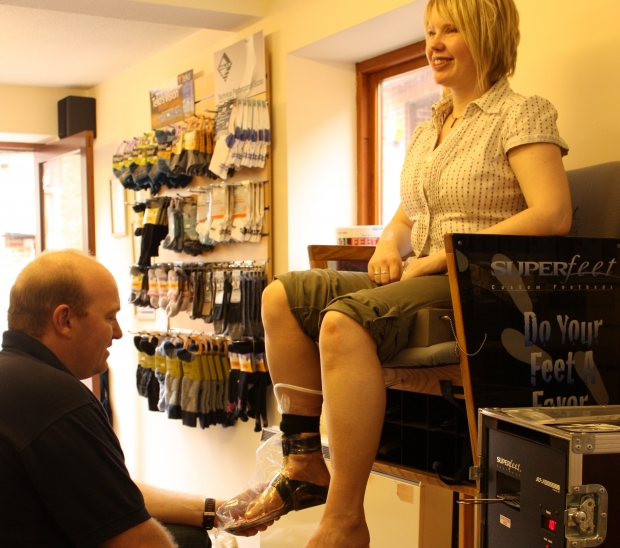No one can enjoy skiing with uncomfortable boots or foot pain. It’s at least an annoyance that distracts you and at most, causing pain and bruising which can last for days even after you’ve stopped skiing.
So how can you be sure the new boots you’re looking at are going to fit? Or maybe you already have boots and they aren’t quite as comfortable as they were in the shop when you tried them on. There’s a few simple checks you can do, and things to look for when buying or checking boots to make sure they fit properly.
Ski boots are sized using the Mondopoint system. This is an ISO standard footwear sizing system which is based on mean foot length in mm (or sometimes cm), so a mondopoint size of 260 or 26.0 would be a foot length of 260mm, it’s as simple as that. However, if you search online for mondopoint conversion charts, you’ll find that there are some variations in what the conversions are thought to be, varying by about a half size in some cases. The other thing that’s often overlooked is the width of the boot, often referred to as ‘last’ size. Technically the last is the shape of the foot or plan that the boot is created around but it’s often used, for ski boots, to give the width measurement.
As a result of the variations in size conversion charts and the different last widths available depending on make and model of boot, you should forget your normal shoe size for all but a guide to what size of boot you should take.
One of the most common mistakes when fitting boots, is to get a boot that’s too large to compensate for a last that’s too narrow. If you find a boot you’re trying is a good length, but feeling tight across the toes, then don’t be tempted to go up a size. First try and find another boot of the same size but with a wider last, otherwise you might end up with a boot that’s too big for your foot in every dimension but width at the fore-foot. Sometimes injected liners, heel lifts and other ‘fitting’ techniques are used to try and compensate for a boot that’s too large, but after skiing for a few weeks, the liner will pack down and you’ll still be left with a boot that’s too large.
There’s a simple check that should be done when fitting boots, and that’s the shell-check. This is something you can do yourself.
Pull the liner out the boot and put your bare foot into the empty shell. Slide your foot forward until your toes just touch the front of the inside of the shell. You should be able to fit 1 or 2 fingers into the gap between your heel and the back of the shell. A shell fit that is larger than 2 fingers will normally end up too loose once the liner has packed down.
Also center your foot side to side in the shell and see if you can fit a finger between the shell and both sides of your ankle. Your ankle shouldn’t be touching the shell at all.
An oft quoted, albeit tongue in cheek rule of ski boot fitting is that if it’s comfortable in the shop then it’s probably too big.
Once you’ve got a decent pair of standard boots that seem to fit well, ski in them for a few days, break them in, bed them down, just generally get used to them, and allow them to shape themselves to your foot. If, after that, you feel there’s some discomfort, go and see a professional boot fitter. There’s an incredible amount you can do with a stock boot before resorting to injection moulding or custom shells, and unless you have very specific requirements or problem feet, then you probably won’t need much done.
While the most important thing is a good fit, the flex characteristics of the boots is a significant consideration. Mondopoint, DIN and other standards related to ski equipment are ISO approved, but flex ratings are not standard across brands, perhaps not even across different models within a single brand. Boot flex ratings will normally run from 50 through to 130 or above, and should be used as a guide only. As a rule of thumb, a 50-60 flex boot should be used by beginners, with racers and experts looking for a 130flex or higher. The rest of the skiing world will fit somewhere in the middle and the amount of flex you require will depend on height, weight, ability, aggressiveness, type of skiing and perhaps even what you carry when skiing, as it all adds to your total weight.
Find a good bootfitter, and trust in their expertise and experience. The best will allow you to simply discuss your preferred terrain, style, technique and other aspects of your skiing and they will provide the optimum boot for you based on that as well as fit. It may not be the boot you were lusting after from reading the magazine reviews, but is it better to have a shiny boot that matches your aspirations but not your foot nor skiing style or ability, or a boot that fits and performs well, allowing you to enjoy your skiing?
The British Ski Boot Fitters Association provide a benchmark for boot fitting excellence and peace of mind for customers as to where to buy your boots. Individual BSBA members have these boot fitting skills and BSBA retail members have satisfied their stringent membership criteria. The BSBA provides a list of accredited and affiliated bootfitters throughout the UK, so have a look and see if you can find one near you.
http://www.skibootpro.co.uk/Findabootfitter.html
Thanks to Colin at Solutions4feet for the image.

